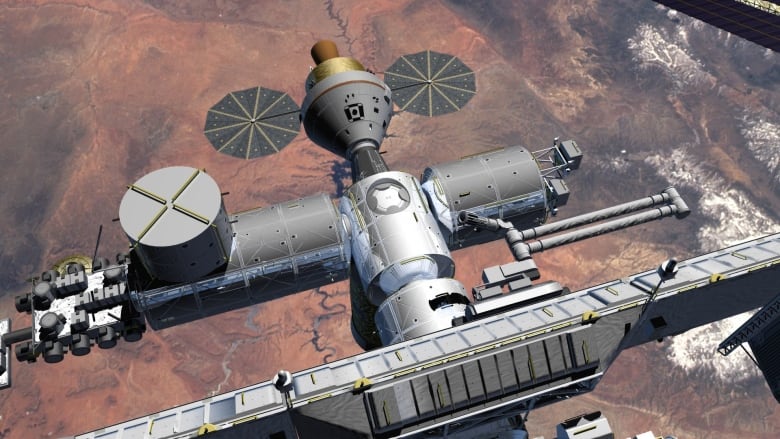Orion spacecraft helps NASA prepare for future Mars journey
NASA was set to takethe first notable step on a long path to send humans to Mars with a test launch of its Orion spacecraft Thursday morning.
The Orion spacecraft, designed to carry astronauts to an asteroid and eventually the Red Planet, was scheduled to blast off from Cape Canaveral, Fla.,on its first unmanned test flight at 7:05 a.m. ET.
A Delta IV rocket will launch the Orion capsule nearly 5,800 kilometres above Earth. That's 15 times higher than the International Space Station and further from Earth than any manned NASA spacecraft since the Apollo moon missions that ended in the early 1970s.
- 'Prepared for change': How to make long-distance space travel happen
- Let's go to Mars, but make sure it's for the right reasons: Bob McDonald
"It's a huge deal," says Olivier de Weck, a professor of aeronautics and astronautics at the Massachusetts Institute of Technology, whose research interests include logistics for space exploration.
The 4-hour Orion mission will test the spacecraft'ssystems, including its heat shield and parachutes. Measurements will be taken of conditions inside Orion's crew cabin, including temperature and radiation levels during the flight, which involves two orbits around Earth.
The capsule will splash down in the Pacific Ocean off Californiaand be recovered.In many ways, Thursday's mission issimilar to the first unmanned Apollo test flights in the late 1960s.

"It's basically learning how to walk again," de Weck said.
The first astronauts are scheduled to fly Orion in 2021. The U.S. space agency says it aims to send humans to an asteroid by 2025 and Mars in the 2030s.
Sending humans to the Red Planet is a dream shared by other nations in 2011, 14 space agencies including the Canadian Space Agency and NASA collaborated on a "global exploration roadmap."It foresees a timeline similar to NASA's, with Mars as the ultimate goal, to be reached after 2033.
China has also expressed interest in sending humans to Mars in coming decades.
Ambitious private plans
Meanwhile, some private companies have more ambitious timelines for reaching the Red Planet.
The Inspiration Mars Foundation led by American billionaire Dennis Tito announced in 2013 that it planned to send a married couple to Mars and back in 2018. Their spacecraft would not land during the 501-day journey, but would come within 160 kilometres of the Red Planet.
Another, the Mars One project, aims to send humans on a one-way trip to establish a permanent human settlement on the Red Planet by 2025.
Canadian space historian and author ChrisGainor is skeptical that those companieswill beat NASA.
"I'll believe it when I see it," he says.
Nevertheless, he does think the interest in Mars has launched a new space race.
"Right now, it's a bit of turtle derby," he said. "But it's moving faster than it did 10 years and certainly 20 years ago."
While Mars has seemed tantalizingly within reach for decades, experts say huge challenges remain before we come close to visiting the Red Planet.

For one thing, Orion itself can only support a crew of astronauts for 21 days, de Weck said. An add-on module "you can think of this as a camper"would have to be developed to support a crew for asteroid missions or the journey to Mars, which would take months.
A Mars mission would also require about 500 tonnes of equipment and supplies to be launched from Earth. Even more advanced versions of the Space Launch System, the rocket being developed to launch Orion, will only be able to carry 130 tonnes per launch, said de Weck.
Another problem is the high radiation levels that astronauts would be exposed to during the long journey through deep space to Mars technology to shield them doesn't yet exist.
"When you're talking about humans on the surface of Mars, then you definitely are talking about very long timelines and hundreds of billions of dollars of money," said Ariel Waldman, a member of the U.S. National Academy of Sciences' former Committee on Human Spaceflight and founder of the citizen science website Spacehack.org.
She and de Weck both think it's a challenge that no country or company can tackle alone.
"I'd be surprised if it wouldn't be an international collaboration that ends up doing it," she said.
Challenge underestimated
Waldman thinks the difficulty of getting to Mars and especially landing on itssurfaceis vastly underestimated by the public. Partly, that's because NASA is vague about what it means when it says it will send humans to Mars in the 2030s.

She added that while she once thought humans would definitely land on Mars in her lifetime, her perspective changed after working with the Committee on Human Spaceflight on a report about the future of the American human space exploration program.
"I have a very real sense that it's not guaranteed," she said. "If it does happen before I die, I should be so incredibly ... thankful for that."
While landing on Mars may still be beyond our reach, de Weck thinks that a Mars flyby by a manned spacecraft proposed by Inspiration Mars may be possible in the near future, though not perhaps by 2018.
"I think it's doable," he said. "To me, that's very exciting."












_(720p).jpg)


 OFFICIAL HD MUSIC VIDEO.jpg)
.jpg)



























































































